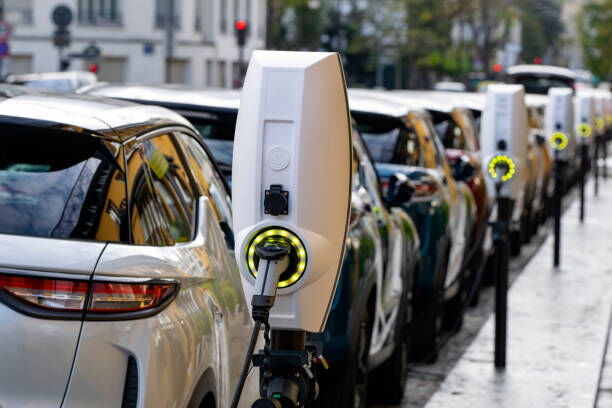The global shift towards electric vehicles (EVs) is accelerating, driven by government policies and consumer demand for greener alternatives to gasoline-powered cars. This growing demand creates a lucrative opportunity for entrepreneurs interested in the commercial EV charging station business. In this article, we’ll explore the essentials of commercial EV charging stations, how to select the right equipment, the benefits of starting a dealership, and the steps to establishing a successful EV charging business.
Commercial EV charging stations are designed to charge electric vehicles in public or semi-public spaces. Unlike residential chargers, these stations are more powerful, capable of charging multiple vehicles simultaneously. They are commonly installed in locations like shopping centers, parking garages, office buildings, and along highways. These stations are crucial for accommodating the increasing number of EVs and ensuring convenient access to charging infrastructure.

Selecting the appropriate EV charging station for your business involves several considerations:
There are three main types—Level 1, Level 2, and DC Fast Chargers. Level 1 chargers are the slowest, suitable for home use. Level 2 chargers are faster and ideal for commercial settings, while DC Fast Chargers offer the quickest charging times and are best for high-traffic areas.
Ensure the chargers you choose are compatible with a wide range of electric vehicles. Some chargers are specific to certain brands or models, so select ones that accommodate the majority of EVs on the market.
Your charging infrastructure should be scalable to accommodate growing demand. Opt for solutions that allow for easy expansion and upgrades.
Modern EV chargers often feature network connectivity for remote monitoring, management, and payment processing. These features enhance the user experience and streamline operations.
Running a successful electric vehicle (EV) charging station business requires more than just providing charging services—it demands ongoing attention to maintenance to ensure smooth operations, customer satisfaction, and steady revenue. EV chargers, especially Level 2 and DC fast chargers, are sophisticated pieces of equipment with various components that require regular upkeep. Below are key maintenance considerations for managing an EV charging station business:
The physical infrastructure of the charging station, including chargers, cables, connectors, and stations, must be maintained regularly. Inspecting the hardware for wear and tear, such as cable damage or connector issues, is essential to avoid operational downtime. Dust, dirt, and moisture can affect charging efficiency and safety, so regular cleaning and weatherproofing are necessary. Periodic checks also help identify hardware components that may need repairs or replacements to prevent malfunctions during customer use.
Efficient power management is critical to ensuring consistent service and avoiding costly energy inefficiencies. It’s essential to monitor and maintain the power supply systems, including transformers, circuit breakers, and wiring. Regular inspection of electrical connections and ensuring that power distribution systems can handle high loads without overheating is key to preventing failures. In DC fast chargers, managing power flow to optimize battery charging while reducing energy loss can enhance system reliability and efficiency.
The payment systems are at the heart of a charging station business, enabling smooth transactions and ensuring revenue collection. These systems need regular updates and testing to handle various payment methods (credit/debit cards, mobile apps, etc.). Monitoring transaction success rates, maintaining software updates, and troubleshooting any issues related to payment processing are critical to minimizing disruptions and ensuring customer satisfaction.
In today’s digital world, connectivity is integral to EV charging station operations. Ensuring the station’s network connection for real-time monitoring, software updates, remote diagnostics, and user interface accessibility is crucial. Regular maintenance of Wi-Fi or cellular connections and ensuring the system’s cybersecurity can help prevent outages, data breaches, or system failures.
By focusing on these critical maintenance areas, you can keep your EV charging station business running efficiently, enhance customer experience, and ensure sustainable profitability.
Starting a commercial EV charging station dealership offers numerous advantages:
With the rapid expansion of the EV market, there is increasing demand for charging infrastructure. Entering this market early positions you to benefit from its growth.
EV charging stations can generate revenue through charging fees, advertising, and partnerships with local businesses.
Expanding EV infrastructure helps reduce greenhouse gas emissions and promotes sustainable transportation.
Many governments provide incentives and subsidies for installing EV charging stations, which can lower initial setup costs.
Providing EV charging solutions can enhance your brand's reputation as a forward-thinking and environmentally conscious business.
Research the EV Charging Station Market: Conduct thorough research on market trends, demand, and competition. Identify potential locations and assess the demographics and behavior of EV owners.
Partner with reputable manufacturers or suppliers to ensure the quality and reliability of your chargers. Look for companies with strong track records and comprehensive support.
Explore dealership programs offered by suppliers. These programs typically include benefits such as training, marketing support, and discounted pricing. Evaluate how these programs align with your business goals.
Submit your application to the selected supplier, including business plans, financial statements, and other required documentation. Ensure you meet all criteria and provide accurate information to increase approval chances.
After approval, set up your EV charging stations in strategic locations for high visibility and accessibility. Implement efficient payment systems and consider offering additional services to enhance the customer experience.
Focus on exceptional customer service, respond to inquiries and feedback, and create loyalty programs. Engage with the local community and participate in events to raise awareness of your services.
Starting a commercial EV charging station business is a promising venture with significant growth potential and positive environmental impact. By researching the market, selecting the right equipment, and following the outlined steps, you can establish a successful dealership and contribute to the expansion of EV infrastructure. As the world transitions to electric mobility, your business will play a vital role in supporting this green shift.
